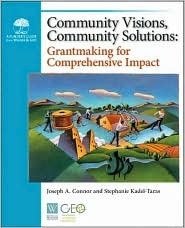
Whether it is a city, town, school, or district, what has surprised me most is that I have never had to talk a community down from too high an aspiration. I have never felt the need to pull back the reigns because a community was getting their expectations too far ahead of their potential grasp.
Now this isn’t to ignore the sorry reality that communities often fail to achieve suboptimal results, but, as I have seen time and time again, that is a function of implementation and not of aspiration. In fact, in my experience, those communities that tend to stretch the limits of expectation also tend to apply more rigor to their implementation, understand the need to reach across the community, and emphasize measurement planning because they intuitively know that this transcendent goal requires them, as a community, to get out of the “same ol’ same ol’” mindset of most past “community betterment” endeavors.
We’ve talked about some of the potential speed bumps before (see my blog posting on “Traps”), and avoiding them is at the center of what I have called “Working Differently.” Here is one simple suggestion to get your analysis off to a better chance to get to the “Big Hairy Audacious Goal” that Jim Collins underscored as a fundamental driver in those organizations moving from “Good to Great.”
SWOT v. SOART
Most of us, who have ever participated in or facilitated a strategic planning session, are very familiar with the warhorse of organizational analysis – SWOT. Strengths, Weaknesses, Opportunities, Threats. The group would take several hours to fill several pages of flipchart paper with their assessment of community characteristics that fit under each of these headings. I used the process for years. It engendered a lively discussion and helped to get people with vastly different perspectives, biases or sector experience closer to being on the same page.
So far so good. But over the years, I began to suspect that this very process was effectively lowering the horizon. In the same way that a gun sight can be bent forward, SWOT tended to create a context where the ultimate shot was low. Under achieving became self-fulfilling.
I think there are two dynamics at play here. First, a community usually only opens itself for a “strategic” review when it already knows that it has problems. An intuitive sense of community weakness is at the heart of the “call to action.” This is anecdotally born out by the fact that usually the newsprint sheets labeled “weakness” often had significantly more entries and more unanimity than any of the other headings. Second, “weaknesses” tend to give permission to the problem. How many times have we heard something “outside our control” as the reason we have the problem – the why we can’t succeed. Poor parenting: school outcomes. Fast food: obesity health care. Economic deterioration: pollution. Media: teen pregnancy. All of which, serves to confirm why we have the problem without serving to sufficiently guide us to the transformative solution. Even the 180-degree different strengths-emphasis of asset maps tends to fail in this development of a clear guide, because these asset maps are most often framed as activity resources from the problem perspective rather than from the solution point of view. (Is it an asset to have more slots for early childhood, if the number of children who become k-ready doesn’t change?)
What I saw was needed was more intentionality about the aspiration and then more rigor regarding the characteristics of achieving that aspiration – that transformative outcome. We all have weaknesses; it is those of us who focus on the change state that soar above those weaknesses.
That is why, several year ago, I switched to SOART. Strengths, Opportunities, Aspirations, Resources, and Threats. In many ways, it is very much the same flipchart process, but by re-defining the headings (i.e., the sight line of the participants) and encouraging iteration across the sheets I witnessed significantly enhanced discussions. The results have been eye opening. Not only are the collective sights raised but also the ultimate time to result has shrunk.
Don’t be naive about your weaknesses, but also, don’t let them limit your expectations.
To be tweeted links to my new posts -- blog, book reviews (both nonfiction and fiction), data or other recommended tools -- either go to Twitter.com and follow me @jcrubicon, or just go to my Home page and click on the Twitter button on the right, just above the tweet stream, and follow me @jcrubicon.
 RSS Feed
RSS Feed
